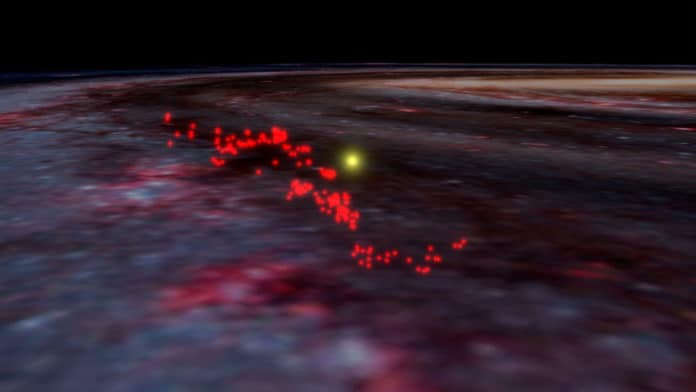Astronomers at Harvard University have discovered a monolithic, wave-shaped gaseous structure- consisting of interconnected stellar nurseries in our galaxy. Dubbed as Radcliffe Wave, the structure is the largest ever seen in our galaxy.
The structure was discovered about 9,000 light-years long and 400 light-years wide, with a wave-like shape, cresting 500 light-years above and below the mid-plane of our galaxy’s disk. As scientists observed many of the stellar nurseries, they primarily thought the nurseries must be the part of ‘Gould’s Belt.’
Initially, the study was enabled by a new analysis of data from the European Space Agency’s Gaia spacecraft. Then by combining the data from Gaia with other measurements, scientists constructed a detailed, 3D map of interstellar matter in the Milky Way. They also observed an unexpected pattern in the spiral arm closest to Earth.
Alyssa Goodman, the Robert Wheeler Willson Professor of Applied Astronomy, a research associate at the Smithsonian Institution, said, “No astronomer expected that we live next to a giant, wave-like collection of gas — or that it forms the local arm of the Milky Way. We were completely shocked when we first realized how long and straight the Radcliffe Wave is, looking down on it from above in 3D — but how sinusoidal it is when viewed from Earth. The Wave’s very existence is forcing us to rethink our understanding of the Milky Way’s 3D structure.”
João Alves, a professor of physics and astronomy at the University of Vienna said, “Gould and Herschel both observed bright stars forming in an arc projected on the sky, so for a long time, people have been trying to figure out if these molecular clouds form a ring in 3D. Instead, what we’ve observed is the largest coherent gas structure we know of in the galaxy, organized not in a ring but a massive, undulating filament. The sun lies only 500 light-years from the Wave at its closest point. It’s been right in front of our eyes all the time, but we couldn’t see it until now.”
“We don’t know what causes this shape, but it could be like a ripple in a pond as if something extraordinarily massive landed in our galaxy. It passed by a festival of supernovae as it crossed Orion 13 million years ago, and in another 13 million years it will cross the structure again, sort of like we are ‘surfing the wave.’”
Catherine Zucker, Harvard graduate student, said, “We suspected there might be larger structures that we just couldn’t put in context. So, to create an accurate map of our solar neighborhood, we combined observations from space telescopes like Gaia with astrostatistics, data visualization, and numerical simulations.”
Scientists noted, “Now, we can see the Milky Way with new eyes.”
This study was supported by the NSF Graduate Research Fellowship Program (grant no. 1650114, AST-1614941), the Harvard Data Science Initiative, NASA through ADAP (grant no. NNH17AE75I), and a Hubble Fellowship (grant HST-HF2-51367.001-A) awarded by the Space Telescope Science Institute, which is operated by the Association of Universities for Research in Astronomy, Inc., for NASA, under contract NAS 5-26555.
The work is published in Nature.
